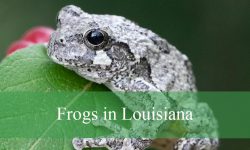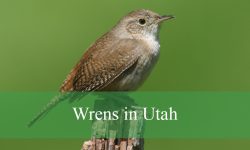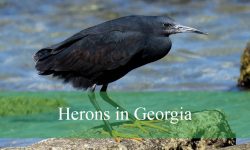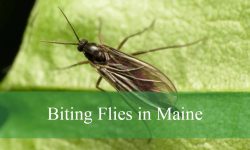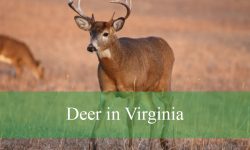Walking through a Maryland forest, I noticed a Red-tailed Hawk circling overhead. Its wide, reddish tail made it easy to spot against the sky.
In a nearby backyard, a Cooper’s Hawk darted through the trees, moving quickly as it hunted small birds. It was impressive to see how agile and fast it was.
Exploring open fields, wetlands, and wooded areas around the state, I discovered many different hawks. Each one has its own look, behavior, and favorite habitat, and this guide will help you identify 10 common and rare species in Maryland.
Common Hawks Found in Maryland
Red-tailed Hawk (Buteo jamaicensis)
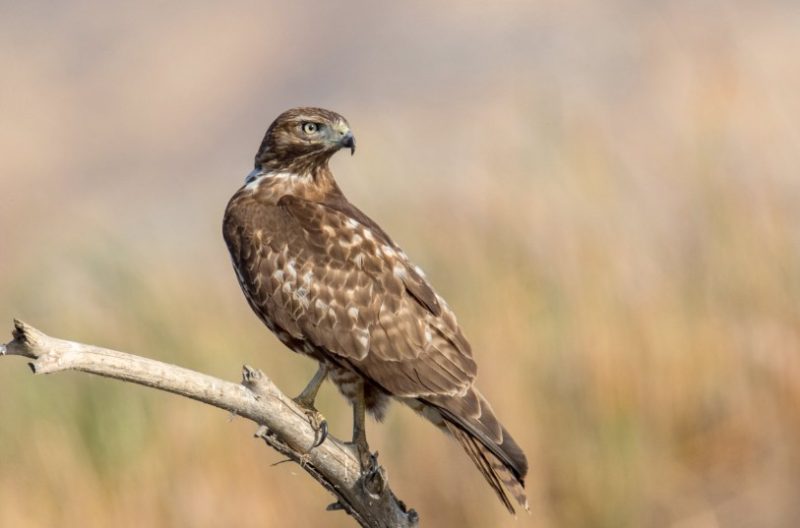
Red-tailed Hawks are one of the most common and easily recognized raptors in Maryland. They are large birds, typically measuring 18–26 inches in length with a wingspan of 43–56 inches. Their broad, reddish-brown tail and pale underparts with a streaked belly band make them unmistakable when perched or soaring.
Identification can be straightforward because adult Red-tailed Hawks have a rich, reddish tail that contrasts with their brown back and lighter chest. Juveniles, however, have a brown, barred tail and streaked belly, which can make them look similar to other buteos. Their broad, rounded wings give them a soaring flight style often seen circling over open fields and highways.
Behaviorally, Red-tailed Hawks are versatile hunters. They prey on small mammals, birds, and reptiles, often perching on trees, poles, or fence posts before swooping down to capture their prey. They are known for their iconic, piercing “kee-ah” call, which is frequently used in movies to represent any hawk or eagle.
In Maryland, Red-tailed Hawks are highly adaptable. They can be found in a variety of habitats, including woodlands, farmlands, suburban areas, and even urban parks. They are year-round residents in most of the state but may show local movement in winter toward open agricultural areas.
Cooper’s Hawk (Accipiter cooperii)
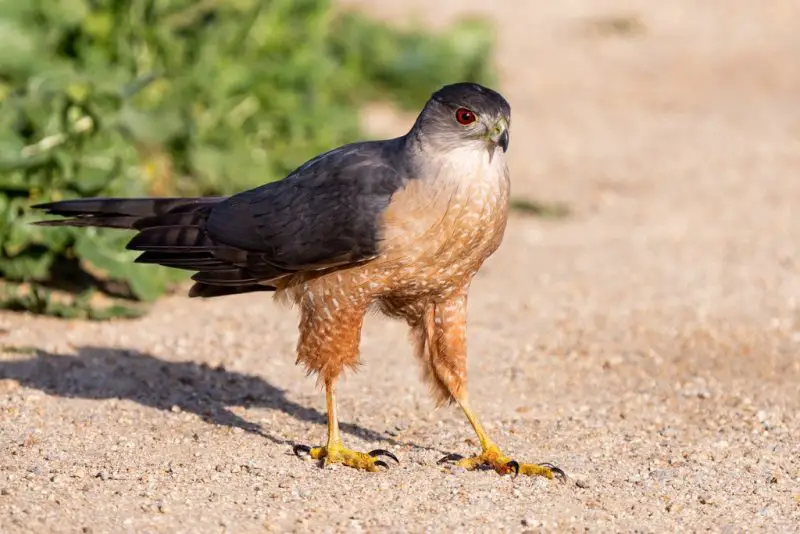
Cooper’s Hawks are medium-sized, agile birds of prey that inhabit Maryland’s forests and suburban neighborhoods. Adults measure 14–20 inches long, with a wingspan of 24–35 inches. They have a long, rounded tail and short, rounded wings that allow them to maneuver through dense trees while hunting.
Identification of Cooper’s Hawks relies on their bluish-gray back and reddish-brown barred chest. Juveniles are brown with streaked underparts. Their tails are typically banded with dark stripes and rounded at the tip, which helps distinguish them from the smaller Sharp-shinned Hawk. Observing their flight pattern—fast, low, and agile—can also aid identification.
Cooper’s Hawks primarily hunt small birds, although they may also take mammals like squirrels or rabbits. They are stealthy hunters, often surprising their prey with quick bursts of flight through trees or shrubs. They perch quietly in wooded areas, waiting for the right moment to strike.
In Maryland, these hawks are most common in forested areas but have adapted well to suburban environments, especially where bird feeders attract prey. They are widespread throughout the state and are present year-round, though juveniles may disperse more widely in the fall.
Sharp-shinned Hawk (Accipiter striatus)
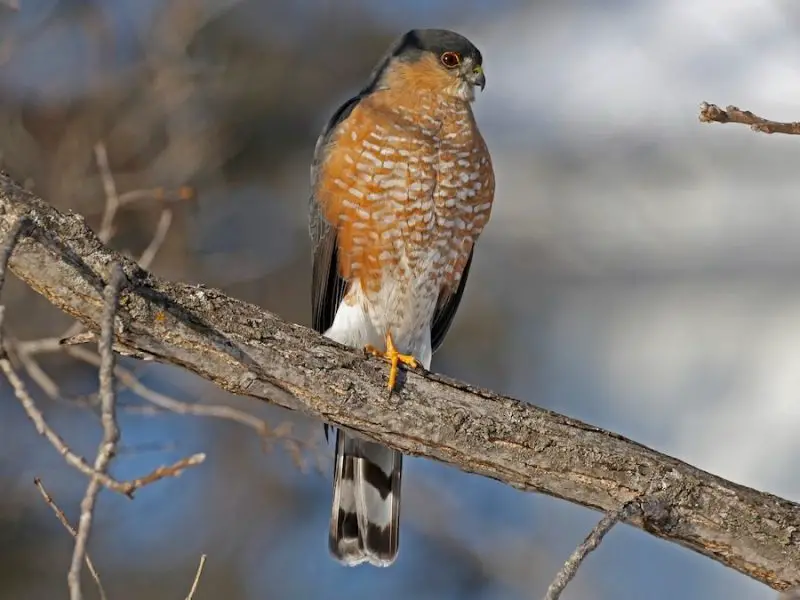
Sharp-shinned Hawks are the smallest accipiters in Maryland, measuring just 9–13 inches in length with a wingspan of 20–27 inches. They are compact, with short, rounded wings and a long, narrow tail, built for quick, agile flight through dense forests.
Adults have a bluish-gray back and finely barred reddish underparts, while juveniles appear brown above with streaked underparts. Their square-tipped tails and rapid, fluttering flight help distinguish them from Cooper’s Hawks, which are larger and have rounded tail tips. Observers often spot them dashing quickly between tree trunks during hunting.
Behaviorally, Sharp-shinned Hawks feed almost exclusively on small birds, making them a frequent presence near bird feeders in Maryland. They rely on stealth and speed, often flying low and fast to catch their prey by surprise. Their flight is characterized by rapid wingbeats followed by short glides.
In Maryland, Sharp-shinned Hawks are found in forests, woodland edges, and suburban backyards. They migrate south in large numbers during the winter, although some may remain in the state year-round if food sources are abundant. They are secretive birds, so spotting one is often a special treat for birders.
Broad-winged Hawk (Buteo platypterus)
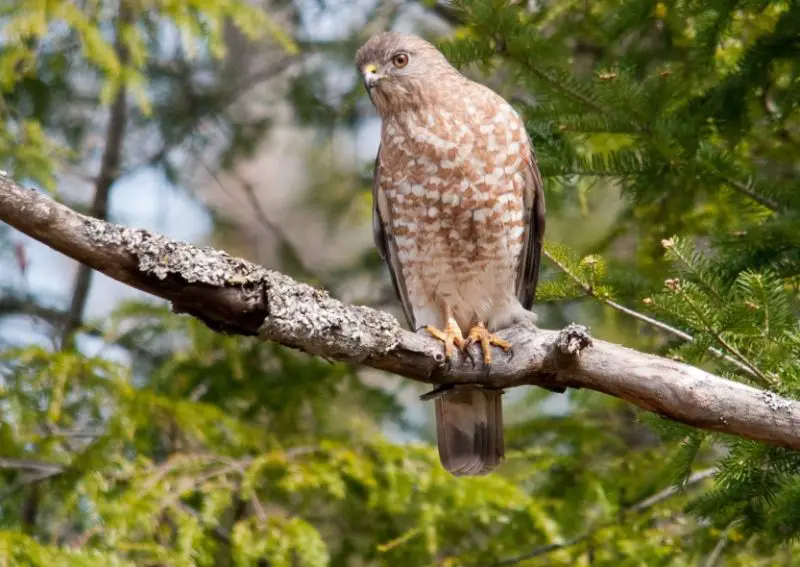
Broad-winged Hawks are medium-sized raptors with a stocky build, measuring 13–17 inches long with a wingspan of 33–39 inches. They are recognized for their broad, rounded wings and short tail, which make them excellent soarers, especially during migration.
Adults have a dark brown back and finely barred chest and belly, while juveniles appear more streaked and mottled. During migration, large flocks of Broad-winged Hawks, called “kettles,” can be seen circling high in the sky over Maryland’s ridges and forested areas. This spectacular sight makes them a favorite for hawk-watchers.
Broad-winged Hawks feed on small mammals, reptiles, amphibians, and insects. They hunt mostly from perches or soaring flight, using their keen eyesight to detect movement on the forest floor. These hawks are social during migration but tend to be more solitary while breeding.
In Maryland, Broad-winged Hawks breed in deciduous and mixed forests, favoring remote areas with large trees. During fall migration, thousands pass through the state, especially along ridgelines and river valleys, making Maryland an important stopover for these birds.
Red-shouldered Hawk (Buteo lineatus)
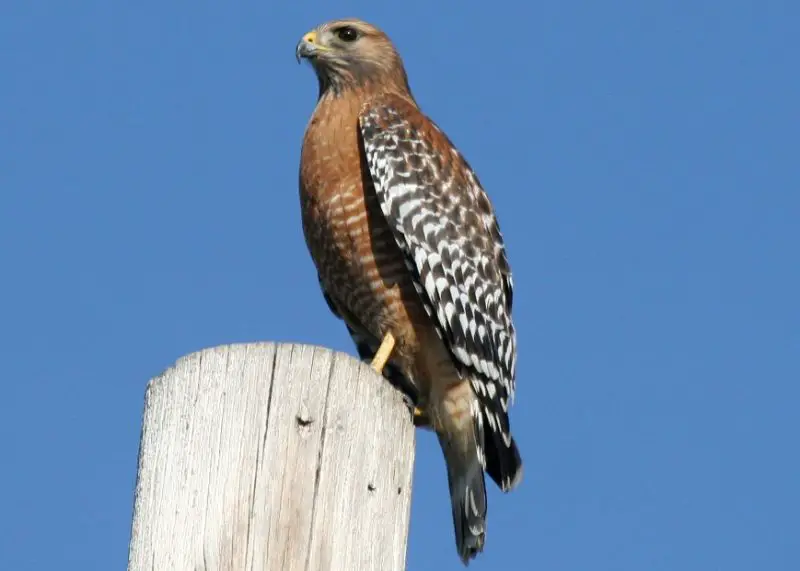
Red-shouldered Hawks are medium-sized raptors measuring 16–21 inches in length, with a wingspan of 37–43 inches. They have striking reddish shoulders, barred underparts, and a checkered black-and-white back that make them easily recognizable in wooded habitats.
Adults have a rich reddish-brown chest and distinctive black-and-white patterned wings, while juveniles appear browner with streaked underparts. Their tail is marked with narrow white bands, helping distinguish them from other buteos. The sharp, “kee-ah” call is often heard before the bird is seen perched along a river or wetland.
Red-shouldered Hawks primarily hunt small mammals, amphibians, and reptiles. They are often found perching in low to mid-level trees, scanning the ground for prey. Unlike Red-tailed Hawks, they prefer shaded, forested habitats rather than open fields.
In Maryland, Red-shouldered Hawks favor swamps, river corridors, and mature deciduous forests. They are year-round residents in much of the state, particularly in areas with ample water and dense tree cover. Their vocalizations are most prominent during the breeding season in spring.
Northern Harrier (Circus hudsonius)

Northern Harriers are medium-sized, slim raptors, measuring 17–20 inches in length with a wingspan of 40–46 inches. They are easily recognized by their long tails, narrow wings, and distinctive owl-like facial disc, which helps them detect prey by sound as well as sight.
Adult males are gray above with white underparts, while females and juveniles are brown with streaked underparts. They fly low over open fields and marshes, often gliding slowly while scanning for small mammals and birds. Their flight is buoyant and graceful, with wings held in a slight V-shape.
Behaviorally, Northern Harriers hunt primarily small mammals, birds, and occasionally amphibians. They use low, methodical flight over grasslands or wetlands to surprise prey. Unlike other hawks, they are highly vocal during flight, producing a distinctive “kek-kek-kek” call.
In Maryland, Northern Harriers are most commonly found in wetlands, marshes, and open meadows. They breed in northern parts of the state and migrate south in winter, making them more visible in mid-Atlantic fields during colder months.
Rough-legged Hawk (Buteo lagopus)
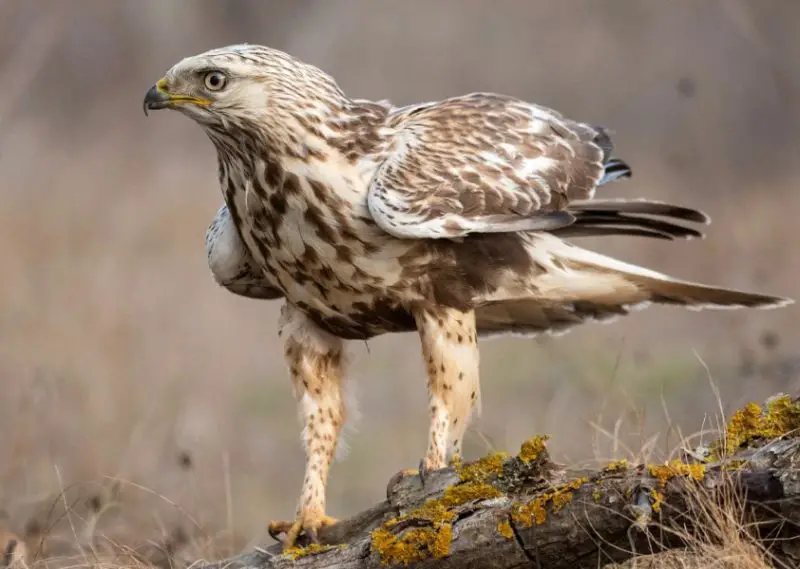
Rough-legged Hawks are large, northern raptors that visit Maryland primarily in winter. They measure 19–26 inches in length with a wingspan of 52–60 inches and have feathered legs that help insulate them in cold climates.
Adults display variable plumage, ranging from pale morphs with light underparts and dark patches on the belly to darker morphs with more uniformly brown coloring. The tail is white with a broad dark band near the tip, which aids in identification. They are slower and more deliberate in flight than other hawks, often hovering while hunting.
Behaviorally, Rough-legged Hawks feed on small mammals such as voles and mice. They are specialized hunters, often seen gliding low over open fields or marshes, scanning the ground for movement. Their hovering ability is notable and makes them stand out from other winter raptors.
In Maryland, Rough-legged Hawks are winter visitors, mostly seen in open agricultural fields, marshes, and coastal plains. Sightings are most common from December through March, when northern populations migrate south to find suitable hunting grounds.
Swainson’s Hawk (Buteo swainsoni)
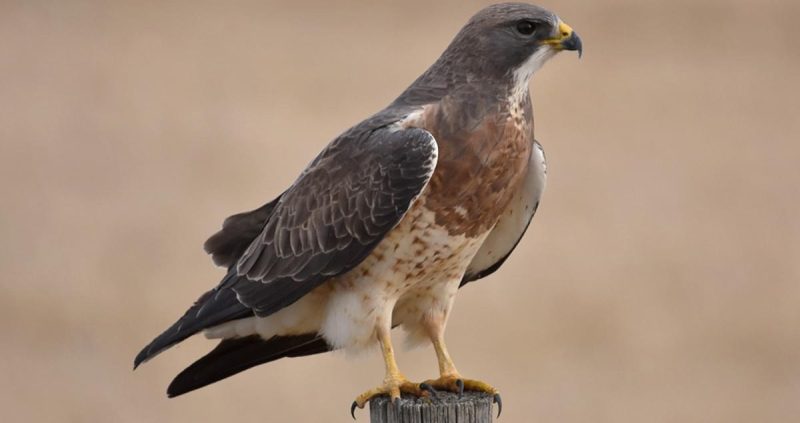
Swainson’s Hawks are medium-sized buteos, measuring 17–22 inches in length with a wingspan of 46–54 inches. They are rare in Maryland, mostly appearing as migrants in the fall. They have long, narrow wings and a relatively slender build compared to other buteos.
Adults have a pale belly and dark flight feathers, with a brown back and variable dark markings on the chest. Juveniles appear streaked and mottled, making them slightly harder to distinguish. During migration, they often travel in small flocks, although large “kettles” have been recorded.
Behaviorally, Swainson’s Hawks feed primarily on insects in summer, especially grasshoppers and locusts, and shift to small mammals during migration. They are known for long-distance flights, sometimes covering thousands of miles between breeding and wintering grounds in South America.
In Maryland, Swainson’s Hawks are primarily seen in the fall as they pass through open fields and farmlands. Their sightings are uncommon, making them a special treat for hawk-watchers and birding enthusiasts.
Northern Goshawk (Accipiter gentilis)
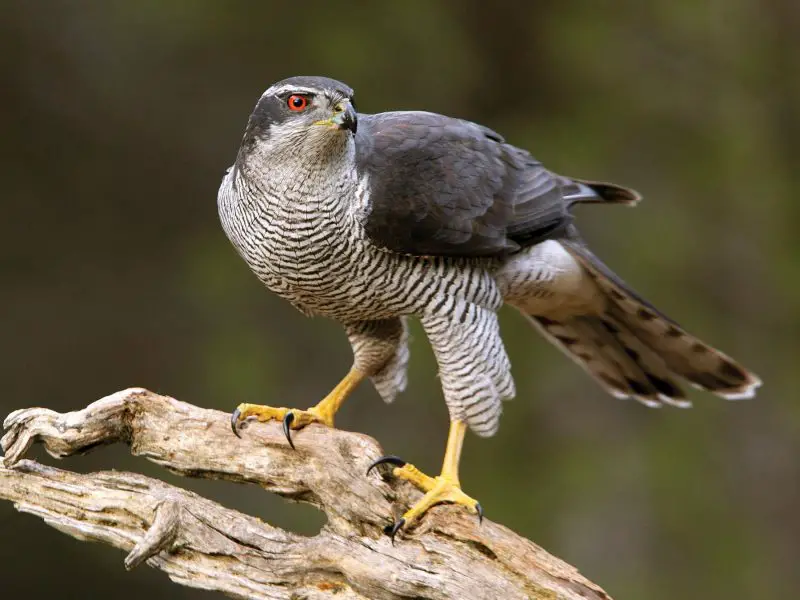
Northern Goshawks are large and powerful accipiters, measuring 20–26 inches in length with a wingspan of 40–46 inches. They have a robust body, broad wings, and a long tail, built for hunting large birds and mammals in dense forests.
Adults have a slate-gray back, white underparts with dark horizontal barring, and a striking white eyebrow stripe above piercing red or orange eyes. Juveniles are browner with streaked underparts and less pronounced facial markings. Their strong, fast flight through trees makes them formidable predators.
Behaviorally, Northern Goshawks are apex hunters of woodland environments. They pursue birds and mammals with great speed and agility, often ambushing prey from concealed perches. They are highly territorial and vocal during the breeding season, giving a loud, sharp “kak-kak” call.
In Maryland, Northern Goshawks are rare and mostly observed in heavily forested areas during winter or as accidental migrants. Because of their secretive nature, sightings are uncommon, making encounters with these birds especially memorable for birders.
Gray Hawk (Buteo plagiatus)
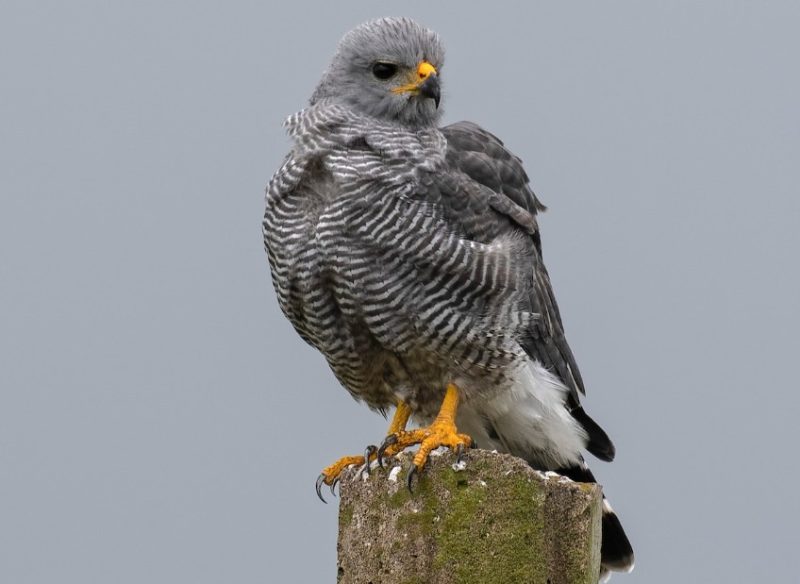
Gray Hawks are medium-sized raptors, measuring 17–22 inches in length with a wingspan of 42–46 inches. They have a slender build compared to other buteos, with relatively broad wings and a long tail that aid in their agile flight through forests and woodland edges.
Adults have a pale gray head, neck, and chest, with darker gray wings and tail. The underparts are whitish with fine barring, and the tail has distinctive dark bands. Juveniles are browner and streaked, making them slightly harder to distinguish from other raptors at first glance.
Behaviorally, Gray Hawks hunt primarily small mammals, reptiles, and birds. They are skilled at maneuvering through trees and perching quietly to watch for prey. Their flight is smooth and gliding, with occasional flaps, and they are generally silent except during the breeding season when they call with a high-pitched, whistling note.
In Maryland, Gray Hawks are extremely rare and considered accidental visitors. They are more commonly found in the southwestern United States and Mexico, so sightings in the mid-Atlantic are noteworthy and exciting for birders. Their preferred habitats are riparian woodlands, forests, and areas near rivers or streams.
FAQs about Hawks in Maryland
What types of hawks are commonly found in Maryland?
Maryland is home to a variety of hawks, including Red-tailed Hawk, Cooper’s Hawk, Sharp-shinned Hawk, Broad-winged Hawk, Red-shouldered Hawk, Northern Harrier, American Kestrel, Rough-legged Hawk, Swainson’s Hawk, and Northern Goshawk. Some are residents year-round, while others are migratory visitors.
When is the best time to see hawks in Maryland?
Broad-winged Hawks and Swainson’s Hawks are most commonly observed during fall migration, while Rough-legged Hawks are primarily seen in winter. Red-tailed Hawks, Red-shouldered Hawks, and Cooper’s Hawks are visible year-round. Early morning and late afternoon are usually the best times for spotting hawks.
Where can I observe hawks in Maryland?
Open fields, farmlands, and highways are ideal for spotting Red-tailed Hawks. Forested areas and suburban neighborhoods are favored by Cooper’s Hawks and Sharp-shinned Hawks. Wetlands, marshes, and river corridors attract Northern Harriers and Red-shouldered Hawks. Hawk-watching ridges are great for observing migrating Broad-winged Hawks.
How can I identify different hawk species?
Look at size, wing shape, tail shape, coloration, and flight patterns. Red-tailed Hawks have broad, rounded wings and reddish tails. Cooper’s Hawks are medium-sized with long, rounded tails. Sharp-shinned Hawks are smaller with square-tipped tails. Broad-winged Hawks are stocky with broad wings, while Red-shouldered Hawks have reddish shoulders and barred underparts.
What do hawks eat in Maryland?
Hawks primarily feed on small mammals, birds, reptiles, and insects. Red-tailed Hawks and Broad-winged Hawks eat small mammals and birds. Cooper’s and Sharp-shinned Hawks focus mostly on birds. Northern Harriers feed on small mammals and birds in marshes, while American Kestrels often hunt insects and small rodents.
Are any hawks in Maryland threatened or protected?
All hawks are protected under the Migratory Bird Treaty Act. While most species are stable, populations of American Kestrels and some migratory hawks have declined in recent decades due to habitat loss. Conservation efforts focus on preserving open fields, wetlands, and nesting habitats.

